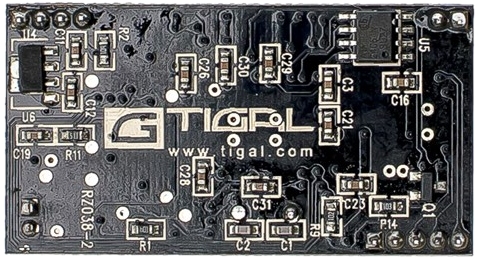
Versione 2.0
ultimo aggiornamento
16 gennaio 2014

|
|
 |
La EasyVR Shield versione 2 si presenta come un normale Shield, su di esso spicca nella parte centrale una piccola schedina delle dimensioni di 45x24 mm: un modulo EasyVR.
Il firmware del modulo EasyVR 2.0 rispetto alla precedenti versione introduce tre nuove funzioni:
Comandi personalizzati
indipendenti
Si possono creare sino a 28 comandi personalizzati Comandi Indipendenti
SonicNet
Controllo di uno o più moduli EasyVR 2.0 in modalità wireless tramite
comandi sonori generati dal modulo o da qualsiasi altra sorgente sonora.
DTMF Tone Generation
Possibilità di creare tramite il modulo EasyVR 2.0 toni DTMF
standard.
IMMAGINI DELLA VERSIONE 2.0



U1: il processore principale prodotto
dalla Sensory,
è il modello RSC-4128 nella versione DIE in cui
l'involucro protettivo è rappresentato da una goccia di resina.
U2: è una memoria SST 39VF040 del
tipo Flash con una tensione di alimentazione 2.7-3.6V, la sua capacità è
di 4 Mbit ed è garantita per 10.000 cicli di registrazione.
U3: è uno speciale integrato GTL2002
prodotto dalla che permette di traslare i livelli di tensione di 5V dal
lato TTL del robot a quelli 3.0V della scheda VRbot.
U4: è un regolatore di tensione positiva tipo
S1131 prodotto dalla Seiko Instruments Inc con un basso low dropout,
alta precisione della tensione di uscita e un basso consumo realizzato
con tecnologia CMOS.
U5: è una memoria EEprom tipo 24LC64
prodotta dalla Microchip, ha una capacità 64k del tipo 2-wire serial
interface.
X1: è un risuonatore ceramico che fornisce il clock al processore
ed ha un valore di 3.58MHz.
Sullo shield sono inoltre presenti due integrati U1 e U2 tipo 74HC125 Quad buffer/line driver; 3-state, più diversi transistor SMD per l'adattamento dei livelli.
RSC-4128
SPEECH RECOGNITION MICROCONTROLLER
The RSC-4128 represents Sensory’s next generation mixed signal processor for speech and analog I/O. The RSC-4128 is designed to bring advanced speech I/O features to cost sensitive embedded and consumer products. Based on an 8-bit microcontroller, the RSC-4128 integrates speech-optimized digital and analog processing blocks into a single chip solution capable of accurate speech recognition; high quality, low data-rate compressed speech; and advanced music.
Products can use one or all features in a single application.
The RSC-4128 operates in tandem with Sensory Speech™ 7 firmware,
an ultra compact suite of recognition and synthesis technologies. This reduced software footprint enables, for example, products with over 150 seconds of compressed speech, multiple speaker dependent and independent vocabularies, speaker verification, and all application code built into the RSC-4128 as a single chip solution.
Revolutionary Text-to-Speaker-Independent (T2SITM) technology allows the creation of SI recognition sets by simply entering text.
In addition to improved recognition performance, the RSC-4128 provides further on-chip integration of features.
FEATURES
FULL RANGE OF SENSORY SPEECH™ 7 CAPABILITIES
Enhanced Word Spotting capability (10 SI or 4 SD words) in parallel
Noise robust Speaker Independent, Dependent & Continuous Listening recognition
High quality, 3.7-7.8 kbps speech synthesis & sound effects with Sensory “SX” synthesis technology
Speaker Verification (SVWS) – Noise robust voice biometric security
8 voice MIDI-compatible music synthesis coincident with speech; drum track feature enables additional voices
Voice record & playback
Audio wake up from sleep
INTEGRATED SINGLE-CHIP SOLUTION
8-bit microcontroller
On-chip 16 bit ADC, 10 bit DAC and microphone pre-amp
Independent, programmable Digital Filter engine
Uses low cost 3.58MHz crystal (internal PLL)
4.8 KB total RAM (256Bytes user-RAM)
Five timers (3 GP, 1 Watchdog, 1 Multi Tasking)
Twin-DMA, Vector math accelerator, and multiplier
External memory bus: 20-bit Address(1Mbyte), 8-bit Data
On chip storage for SD, SV, templates (10 templates)
Code security through no ROM dump capability
Built-in Analog Comparator Unit (4 inputs)
Low EMI design for FCC and CE requirements
24 configurable I/O lines with 10 mA (typical) outputs
Fully nested interrupt structure with up to 8 sources
LONG BATTERY LIFE
2.4 – 3.6V operation
12mA (typical) operating current at 3V
2 low power modes; 1 µA typical sleep current

| Processore RSC-4128 | ||
 |
 |
|
| Piedinatura | Datasheet | Foto dell'integrato |
| Memoria Flash - SST 39VF040 4 Mbit | ||
 |
|
 |
| Piedinatura | Datasheet | Foto dell'integrato |
| GTL2002 - 2-bit bidirectional low voltage translator | ||
  |
|
 |
| Piedinatura | Datasheet | Foto dell'integrato |
| S1131-E - high ripple-rejection low dropout middle output current cmos voltage regulator | ||
 1-Vout 2-GND 3-Vin |
|
 |
| Piedinatura | Datasheet | Foto dell'integrato |
| Memoria 24LC64 - 64K I2C™ Serial EEPROM | ||
 |
|
 |
| Piedinatura | Datasheet | Foto dell'integrato |
| 74HC125 Quad buffer/line driver; 3-state | ||
 |
|
 |
| Piedinatura | Datasheet | Foto dell'integrato |
| Elenco revisioni | |
| 18/07/2016 | Emissione preliminare |